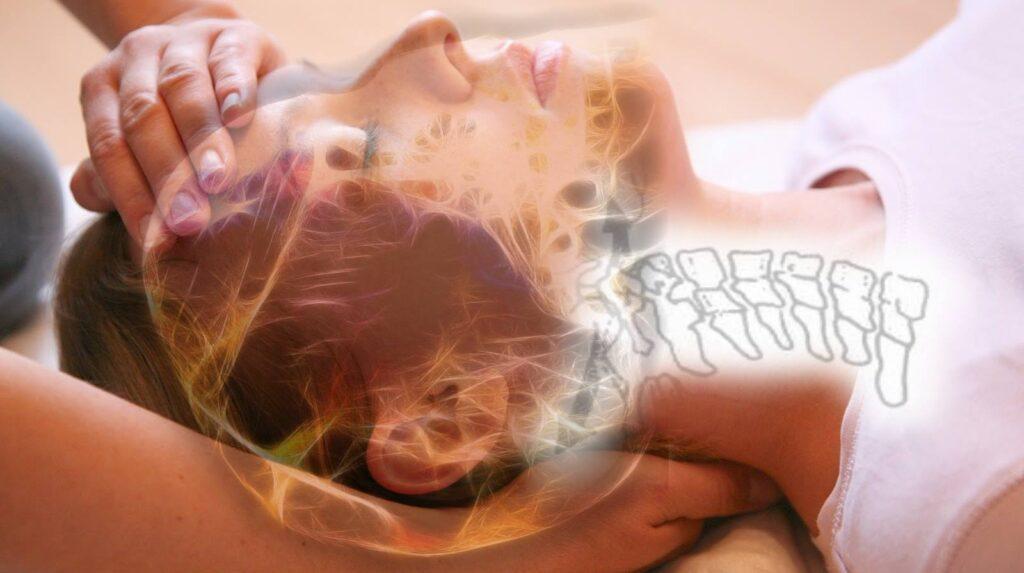 This article presents an integration of Biodynamic Craniosacral Therapy and Chinese Medicine. It is a study in progress. Enjoy!
This article presents an integration of Biodynamic Craniosacral Therapy and Chinese Medicine. It is a study in progress. Enjoy!
Source: By Dr. Arthur Akhmetsafin, M.D. (Department of Neurology and Traditional Medicine of Pavlov`s State University of St.-Petersburg)
“…We should point out some common traits of the “craniosacral” conception and Chinese medicine. Among all the systems of body function an evident analogue of the craniosacral system is so called “governing vessel”, or Du Mai (督脉), one of the most important “pulsating vessels” in the system of “Eight extraordinary vessels” – Ba Qi Mai (八奇脉), and, in particular, this is “the Sea of Yang” – here the energy of “Six Yang meridians” – Liu Yang Jing (六陽經) is united. Acupuncturists often fail to take into consideration that actually not six, but twelve Yang meridians are united here (because they are paired). It is known that in each side of the body there are 12 meridians (six Ying and six Yang meridians), i.e. in general there are 24 meridians, Er Shi Si Jing (二十四經).
The place where the “energy” of the left and the right sides is united is located in the area of the suture between maxilla bones above incisors and below nasal partition (sutura intermaxillaris)
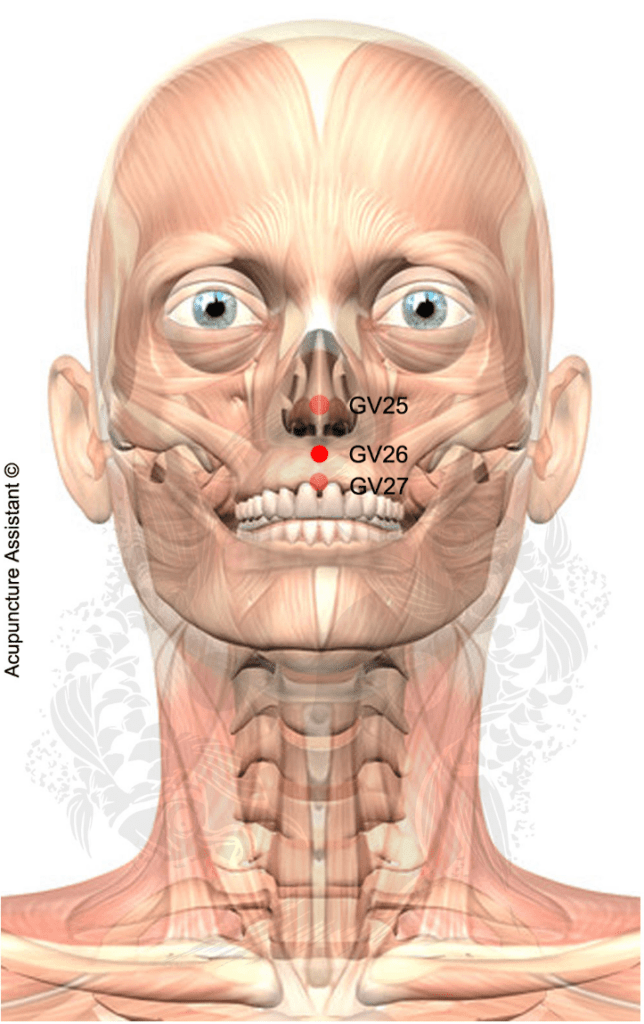
This left-right meeting point of the body at the acupuncture point GV-26, ending point of the DuMai Extraordinary Meridian, corresponds to the upper jaw central suture, called “sutura intermaxillaris”.
It seems to be reasonable to add this survey to materials dedicated to craniosacral therapy (14), and as we will see below this is related not only to the history of the problem, or the issue of priority, but also to other causes. Without detracting from W.G.Sutherland’s merit we have to mention centuries – old experience of Chinese medicine in the area of technique called up to now Xi Sui Jing (洗髓經) – ‘Treatise on Washing the Brain’ (according to the name of the main treatise describing this technique), or Jin Gang Xi Sui Jing (金剛洗髓經), – ‘Diamond Xi Sui Jing’ (by analogy with Buddhish ‘Diamond Sutra’).
Though the ultimate aim of such technologies was obtaining ‘religious enlightenment’, ‘long life’ – Chang Sheng (長生), and even ‘immortality’ – Bu Si (不死), Xi Sui Jing was also used for more prosaic purposes: improving health, increasing vitality and conditioning the body.
Till recently this system was believed to be a secret, and the texts describing the essence of the techniques come to nothing more than general notes. They are written in the form of a short summary, and their content is vague without competent reviewers. Contemporary followers of this system affirm that, until now, one lesson given by an expert of the ‘washing the brain’ technique may cost an impressive sum of money, with condition of a ban on further transmission of knowledge.
Along with Xi Sui Jing (洗髓經) other similar techniques exist, such as Yi Jin Jing (易筋經), also thus named according to the name of the main work on this subject ‘ ‘Treatise on the Change of Tendons (and Muscles)’, Liu Zi Jue (六字訣) – ‘Incantation by Six Characters’ (art of conducting sung songs through the organs and tense meridians), Chi Shui Xuan Zhu (赤水玄珠) ‘ ‘Secret Pearl of Red Waters’ and others. In contemporary China, all these techniques are grouped one way or another under the term of Qi Gong (氣功) – literally translated as ‘work (with) energy’, and are mainly used for sanitary and curative purposes, though in former times they were used sometimes for exactly the opposite purposes (8).
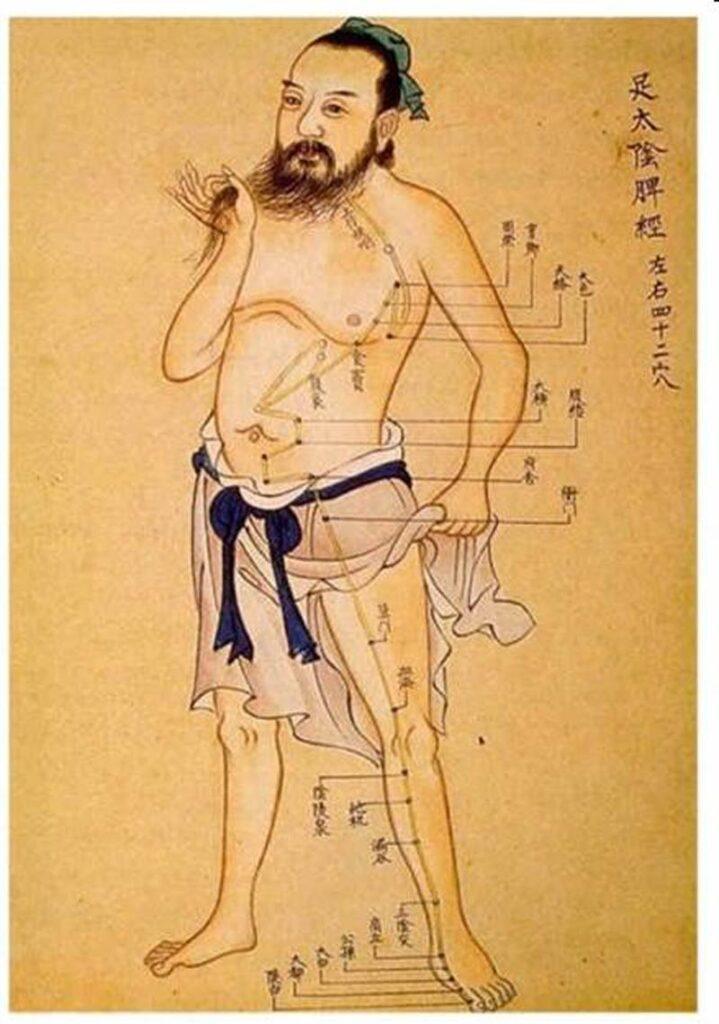
“Without detracting from W.G.Sutherland’s merit we have to mention the centuries – old practice in Chinese medicine called Xi Sui Jing (洗髓經) ‘Washing the Brain’ , used for spiritual enlightenment, improving health, increasing vitality, and conditioning the body.”
However, in the ‘Five Methods’ classification of Chinese medical science Zhong Yi Xue (中醫學), according to the texts of Yellow Emperor Huang Di Nei Jing (黄帝内經), all these techniques have to be referred to the methods called Dao Yin An Qiao (導引按蹻), literally translated as ‘To channel and to Tense, to Press and to Stretch’. This is one of the ‘Five Methods’ of Chinese medicine (2), together with Du Yao (毒樂) – treatment by the methods of ‘Poisons and medications’ (pharmacotherapy and toxicology), Jiu Bing (灸炳) use of ‘smoldering (herb) and cauterization’ (thermogenotherapy), Bian Shi (砭石) – treatment by ‘stone (splinters)’ (mineralopuncture), and Jiu Zhen (九鍼) – ‘Puncture by nine (metallic) needles’ (acupuncture). These methods might be applied for healing the common people (as they were accordingly related to the elements of Wood, Fire, Earth and Metal), as well as on the physicians themselves – to support the effect of those methods and maintain their own health they used the method Dao Yin An Qiao (element Water – ‘kidneys’ – highest possible Yin in the system of the ‘Five Elements’). That is why, as is conventionally believed, the transmission of such knowledge was possible only from one hand to other hand and hence, could not be put towards a common use.
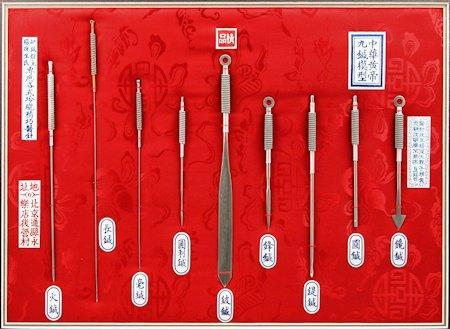 Jiu Zhen Therapy, (九鍼) ‘Puncture by nine (metallic) needles’ was used in the Han Dynasty (206 BCE-220 CE).
Jiu Zhen Therapy, (九鍼) ‘Puncture by nine (metallic) needles’ was used in the Han Dynasty (206 BCE-220 CE).
In this regard, it is interesting to note that the element Water and the direction to the North -Bei (北) were connected to the deity protecting this part of the world Xuan Wu (玄武) – ‘the Mysterious Warrior’. Besides the connection with the ‘mysterious’, ‘war’, and the cardinal direction of North, as has already been mentioned, the direction of North in the body is represented in the back, Bei (背), which is to be found in the Chinese character’(is the bottom part, ‘flesh’ 肉 , is the upper part, ‘North’ 北 , i.e. ‘the part of the body directed to the North’, hence, the throne of Chinese Emperor is oriented with back- Yang toward the North ‘ and the frontal- Yin part turned to the South) (5,6).
Besides that, in the symbolic bestiary Xuan Wu is the tortoise Gui (龜) twined by snake She(蛇), where the tortoise is the female, and the snake is male. The ‘organ’ connected with the North, hence correlated to Water and Xuan Wu is ‘kidneys’ Shen (腎), which is a pair organ (two testicles, two ureters, two kidneys, two adrenals) is naturally correlated with Yin (隂).
Chinese medical paleography always points out the division of functions of the left (Yang) and the right (Yin) in the organism. And as for inner organs, Zang Fu (臓腑), such bilateral ‘organs’ are the kidneys (and to a lesser extent, the lungs). In contrast to the ‘organs’, Zang Fu, such a place in the ‘meridian system’ lies below the nose at the intersection of the meridians, Shou Yang Ming, as we will further see.
Let us return to the ‘washing the brain’ doctrine. The authorship of the ‘Treatise on Washing the Brain’ is attributed to the famous patriarch of Chinese Buddhism and to legendary founder of the martial art style Shao Lin Si Quan Fa (少林寺拳法) ‘ ‘The Shao Lin Monastery Principles of Boxing’, Pu Ti Da Mo, more often called Bodhidharma (8). One finds many curious stories with this name [1] . Furthermore, accordingly to some sources, Yue Fei, the legendary commander of the Song (宋) Epoch used this technique for preparing his special combat subdivisions.
One should note that the initial conception Da Mo certainly clashed with existing theory of the ‘life cultivating’ Yang Sheng (養生) of ancient Taoists’alchemists, and it certainly conflicted with the entrenched theory of body function stated in the texts of the Yellow Emperor Huang Di’(黄帝). Without getting too deep in the spheres of orientalism and textual analysis of medical and Taoist’Buddhist paleography, we should outline principal features of the ‘washing the brain’ technology.
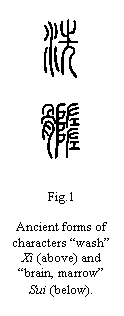 Firstly, let us examine the term Xi Sui (fig.1). The character Xi (above) has the meaning ‘wash, bathe’. The character Sui (below) has the meaning ‘brain, marrow’, and a broader meaning ‘essence’ (compare with the Russian expression ‘to the marrow of one’s bones’) ‘ (5,6).
Firstly, let us examine the term Xi Sui (fig.1). The character Xi (above) has the meaning ‘wash, bathe’. The character Sui (below) has the meaning ‘brain, marrow’, and a broader meaning ‘essence’ (compare with the Russian expression ‘to the marrow of one’s bones’) ‘ (5,6).
The graphic composition of the character Sui (see left) is formed around bone cavity (trabecules, the cavity of tubular bone, of the cranium) with the soft tissue ‘ ‘flesh’ inside it (骨), we mean not only cerebrum and the spinal cord, but the marrow, too. In Chinese anatomic terminology there are characters having more specific meanings, for example Nao (脑)’’brain’. Thus, Sui is a generalized notion meaning everything located in the bone cavities from the smallest (spongy substance) to the biggest (spinal channel and cranial cavity). That is why the word combination Xi Sui should be translated as ‘washing’ or ‘bathing’ the ‘brain’ (and naturally ‘marrow’) [2] .
Now, considering the initial theme of the research, we should point out some common traits of the ‘craniosacral’ conception (14) and Chinese medicine. Among all the systems of body function an evident analogue of the craniosacral system is so called ‘governing vessel’, or Du Mai (督脉). In general, this is one of the most important ‘pulsating vessels’ in the system of ‘Eight extraordinary vessels’ ‘ Ba Qi Mai (八奇脉), and, in particular, this is ‘the Sea of Yang’ ‘ here the energy of ‘Six Yang meridians’ ‘ Liu Yang Jing (六陽經) is united. Acupuncturists often fail to take into consideration that actually not six, but twelve Yang meridians are united here (because they are paired). It is known that in each side of the body there are 12 meridians (six Ying and six Yang meridians), i.e. in general there are 24 meridians, Er Shi Si Jing (二十四經). The place where the ‘energy’ of the left and the right sides is united is located in the area of the suture between maxilla bones above incisors and below nasal partition (sutura intermaxillaris) ‘ (8,11).
From the point of view of Chinese medicine this area is correlated with ‘the middle region’ in ‘the area of Heven’, in other words, this is a ‘Man in the Heven’. This point – and we should note that in Chinese medicine these are not points, but ‘holes’, Xue (穴) – is called ‘orifice into the center of the Man’ ‘ Ren Zhong Xue (人中穴). Here the left and the right meridians intersect ‘the Light Yang (between) the hand and the large intestine’ [3] . The above-mentioned phenomenon of intersection is related with the topographic feature of this meridian: this is the only meridian that crosses to the opposite side, and this crossing is just below the nose in the indicated point Ren Zhong Xue. The reanimation property of this point is known, and it is effective against headaches [4] .
According to classic theory, an energy, Qi, (氣) functions in the body. To be more precise, there are two kinds of this energy. The first one is formed in the embrionic period ‘ this is ‘Original Qi’ Yuan Qi (元氣), that is why it is also called ‘the Energy of the the Earlier Heaven’ ‘ Xian Tian Qi (先天氣), i.e. innate energy (compare in craniosacral terminology ‘primary respiration’). The other is ‘exterior’, i.e. is bound up with external breathing, that is why it is called ‘the Energy of the Following Heaven’ ‘ Hou Tian Qi (後天氣), i.e. appearing with the first breath and after cutting the umbilical cord (compare ‘Secondary respiratory’) [5] .
Besides this, Qi rhythmically functions in the system of meridians, moving in them by rhythmically consecutive or parallel motions, the smallest of which is the rhythm of breathing in and out. Hence, motion across all the chain of meridians is carried out during two breath cycles (one cycle being mainly left, and the other right). The place of transition is the already known ‘point’ located below the nose, ‘The orifice in the middle of Man’. Hence, if we take as the basic rhythm 16-18 cycles per minute, the complete cycle of’’energy’ in the organism occurs 8-9 times a minute. This rhythm should be familiar to experts in osteopathy. We should also mention that this concept exists in the Indian yoga and Sufi traditions, as well as in several Tibet schools of ‘the Diamond Chariot’, etc.

The Du Mai meridian or Governing Vessel begins at DU-1 point, the perineum, called Huiyin, or Convergence of Yin, and extends up past DU-20, the crown of the head, called Baihui, or 100 Point Meeting. It ends at DU-26, Rhenzhong, meaning Water Trough, at the “Sutura Intermaxillaris”, the central suture just below the nose.
Let us return to ‘Governing Vessel’. Its trajectory starts just behind the anus near the base of coccyx (8), that is why the ability to pull up the anus (closing), or to relax the bottom of the pelvis (opening) ‘ is a key ability in Chinese gymnastics. Going up, the ‘vessel’ reaches’the ‘point’ located precisely in the lower orifice of the sacral channel, Yao Shu (腰兪), where the terminal filament (filae terminale) ends ‘ (11), then it goes up to the thoracic – cervical area. Then it rounds the vault of the cranium at the median line (external passage), and at the same time connects with the brain in the parasagittal space (sinus sagittalis et sutura sagittalis), and ends by the root of upper incisors behind the upper lip. Thus, this vessel cannot be called ‘the back median meridian’ as many Western authors do (and after them contemporary Chinese authors, too)
A part of ‘Governing vessel’ corresponds anatomically to the passage of the spinal dura mater cuff, and in the upper part this ‘pulsating vessel’ is connected with the brain and cerebral membranes (together with venous sinuses). The name itself of ‘governing’ vessel means that the ancient physicians knew the function of the central nervous system [6] . This ‘vessel’ has 28 ‘orifices’ which are located by segments along the spinal column, and at the vault of skull [7] .
 Let us examine the craniosacral system from the point of view of Chinese medicine. We start with sacrum, coccyx, and spinal column. The Russian word ‘krestets’ (sacrum) names the bone around which, from four sides, or in the form of a cross, four bones, or joints are arranged (two sacrum-iliac joints, with lumbar part of the spinal column, and coccyx). The Latin equivalent of sacrum (os sacrum) has an etymological meaning which can be traced back to the word ‘sacred’, mysterious, sacral bone (10). As for the Chinese denomination, the most stable term for the sacral and coccyx areas is Wei Lui (尾閭).
Let us examine the craniosacral system from the point of view of Chinese medicine. We start with sacrum, coccyx, and spinal column. The Russian word ‘krestets’ (sacrum) names the bone around which, from four sides, or in the form of a cross, four bones, or joints are arranged (two sacrum-iliac joints, with lumbar part of the spinal column, and coccyx). The Latin equivalent of sacrum (os sacrum) has an etymological meaning which can be traced back to the word ‘sacred’, mysterious, sacral bone (10). As for the Chinese denomination, the most stable term for the sacral and coccyx areas is Wei Lui (尾閭).
Wei (尾) literally translates as ‘tail’, meaning coccyx. Lui (閭)’is ‘village fence’, or ‘village gate’ (5,6). This nuance is also present in Russian ‘krestets (okrestnosti)’, meaning environs, neighborhood. Gates, in the anatomical sense gates (門) are a component of the character Lui (閭), which means not only ‘passage’, but also, and more often, ‘articulation’, ‘joint’. As applied to sacrum, these are left and right sacro-iliac joints between which the sacrum moves (this is called in craniosacral practice ‘sacral pump’, and in the Qi Gong ‘ ‘closing – opening the gate’).
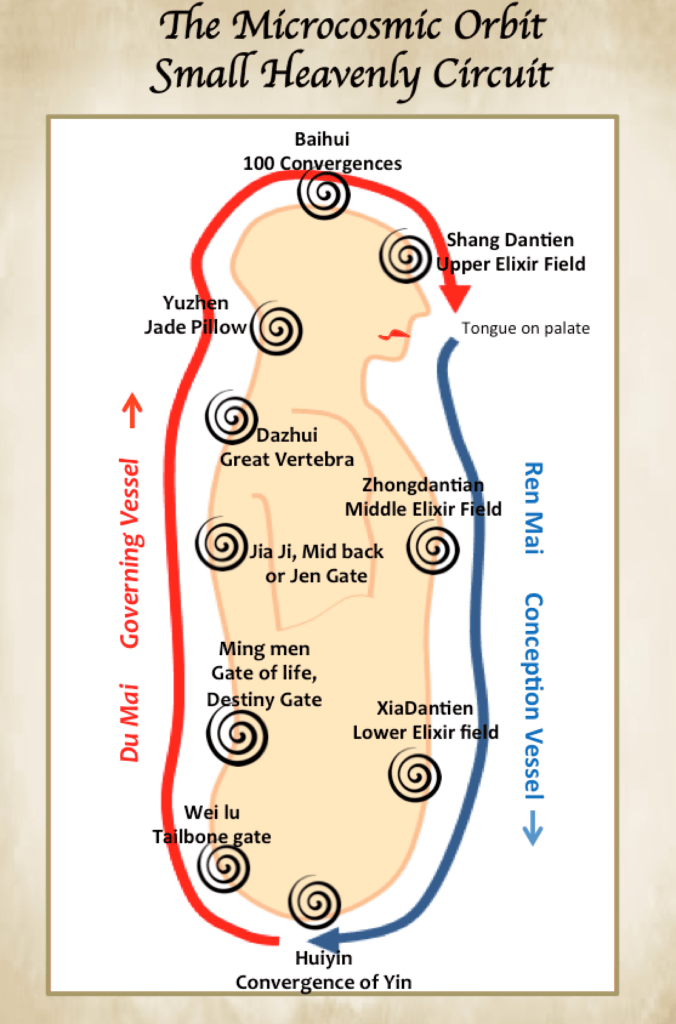
The energetic gates in Daoist internal practice.
As to another component of the character Lui (呂) ‘ ‘spinal column’ (etymologically ‘two vertebrae connected together by ligaments’), from the philological point of view this is ‘phonetic’, i.e. information that indicates how to read the character, but does not have any semantic sense. However, from a medical point of view, the picture is different, as physicians used to attribute sense to each significant term and physicians of any tradition use their own language. So Lui (呂) is the character meaning spinal column, hence, it is directly related to our subject.
This character has one more interesting meaning ‘ ‘frets’ (of musical instruments) (1,5,6), the construction of which is similar with that of the spinal column. We should also mention that Chinese musical scale is also called Liu Liu (呂律), or, by the name of its base tone, ‘Yellow bell’ Huang Zhong (黄鍾).
In Chinese medical theory, terms of musical acoustics are often used. Moreover, the theory of body function is ‘musical’ by its nature. We should remember a well-known citation from the ‘Internal Treatise of the Yellow Emperor’ Huang Di Nei Jing (黄帝内經). In the chapter 78 ‘Discussion About Needles’, in the Ling Shu section (靈樞) we read (3): 夫聖人之起天地之數也 .一而九之.故以立九野.九 而九之.九九八十一.以起黃 鍾數焉.以鍼應數也.
‘The perfectly Wise inferred’number of’Heaven and Earth, from one to nine, and thus established nine localities, nine multiplied by nine gives eighty one, in such a way one calculates the scale Huang Zhong, and so corresponds the number of needles’.
One of the examples of ‘musical’ correspondence with human anatomy is the structure of above-mentioned ‘Governing vessel’ Du Mai (see fig 2). In this sense the notion ‘meridian’ Jing (經) should be translated as ‘string’ ‘ i.e. string with changing tension.
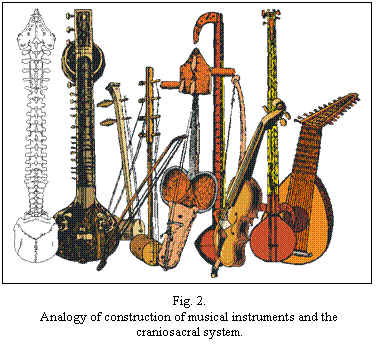 The similarity of the craniosacral system structure and musical instruments is evident: on the bottom (sacrum and coccix) is the system of ‘string’ tension adjustment, on the top ‘ (cranium) ‘ the system of ‘resonators’, with the ‘neck’ (spinal column) and ‘frets’ between them. Also, several constructive elements of Chinese musical instruments (anthropomorphous) have anatomical names (1).
The similarity of the craniosacral system structure and musical instruments is evident: on the bottom (sacrum and coccix) is the system of ‘string’ tension adjustment, on the top ‘ (cranium) ‘ the system of ‘resonators’, with the ‘neck’ (spinal column) and ‘frets’ between them. Also, several constructive elements of Chinese musical instruments (anthropomorphous) have anatomical names (1).
This simple and obvious analogy has a nevertheless biophysical foundation, too, and that is corroborated by bioacoustics research (1,12,13). For example, mathematical calculations of proportionality of the dimensions of vertebrae, the length of the spinal column and the intervertebral disks, the height of the spinal cord segments, the length of the spinal rootlets, etc, show similarities with numerical proportions of the musical instruments fret structure. (1,13). We should add to all this that the presence of direct and reverse piezoeffect in bones discovered in in the nineteen fifties indicates that the bone behaves as a monocrystal [8] .
It is curious to note that if we apply fret correspondences to the spinal column structure, main pentatonic musical intervals will correspond to the key segments ‘ with transitions between the regions of the spinal column and the tips of cyphoses and lordoses (in biomechanics and manual medicine they are known as ‘arcs’ and ‘triangles’ that are the elements of the postural balance).
Let us examine the ‘Chinese’ anatomy of the brain. This is an interesting subject, as anatomy was not developed in Chinese medicine, and dissections were more sporadic than systematic. In this sense, Chinese physicians were more physiologists than morphologists. Thus, according to the Western physician, knowledge of anatomy was impossible in China. However, studying some of some ancient Taoist texts suggests an absolutely different idea to us.
The brain is divided into nine regions, where ‘nine palaces’ are located [9] . In their turn, the ‘nine palaces’ are distributed in the sagittal plane into two ‘floors’. Western researchers taologists believe these ‘palaces’ to be paraphysical objects. We differ with this interpretation and will try to find the anatomophysiological analogies of these ‘palaces’. We find indications of this in the well-known Taoist writings Dong Zhen Tai Shang Dao Jiun Yuan Dan Shong Jing (洞眞太上道君元丹上經) ‘ ‘Superior treatise of the Original Cinnabar of the Supreme Way Sovereign from the Grotto of the Truth’, and Huang Ting Nei Jing Jing (黄庭内景經) ‘ ‘Treatise Explaining the Interior of the Yellow Court’ (7).’
With all the image-bearing character of such names, and in the same way an uninitiated interprets these terms, they mean absolutely concrete ‘regions’ of the organism. For example, ‘Yellow Court’ ‘ Huang Ting (黄庭) may be associated with the minor epiploon (omentum minus) and corresponding space (bursa omentalis), where the pancreas is located (the Element Earth ‘ yellow color). The character ‘grotto’ (洞) (or in a wider sense ‘cave’)’by its composition represents ‘room surrounded by water’, and, as we will further see, refers to the ventricle system of the brain.
So, Taoists distinguish ‘Nine palaces’ Jiu Gong (九宫). Among them, in the lower line from the front to the back, at the distance of the distance of one ‘inch’ Cun (寸) from each other go:
1. Ming Tang Gong (明堂宫) ‘ ‘The Palace of the Light Hall’
2. Dong Fang Gong (洞房宫) ‘ ‘The Palace of the Cave Chambers’
3. Dan Tian Gong (丹田宫) ‘ ‘The Palace of Cinnabar Field’
4. Liu Zhu Gong (流珠宫) ‘ ‘The Palace of Floating Pearl’
5. Yu Di Gong (玉帝宫) ‘ ‘The Palace of the Jade Emperor’
In the upper line, at one Cun from the lower line, beginning from the level Ming Tang Gong, from the front to the back go:
6. Tian Ting Gong (天庭宫) ‘ ‘The Palace of the Heaven Court’
7. Ji Zhen Gong (極眞宫) ‘ ‘The Palace of the Ultimate Truth’
8. Xuan Dan Gong (玄丹宫) ‘ ‘The Palace of the Secret Cinnabar’
9. Tai Huang Gong (太皇宫) ‘ ‘The Palace of the Great’Sovereign’ terminates the line.
In is necessary to make a few remarks here. According to the list of the ‘Explaining Treatise of the Yellow Court’, one uses the term Ni Wan Gong (泥丸宫), ‘The palace of Nirvana’ instead of ‘The Palace of Cinnabar Field’, that is an example of the introduction of Buddhist terms into Taoist psychosomatic terminology. We should also mention that for naming the Sanskrit term Nirvana, the Chinese consonant Ni Wan is used, that literally means ‘clod of mud’, ‘earthen ball’. Thus Ni Wan Gong might either be translated as ‘the Palace of Earthen clod’ and as ‘The Palace of Nirvana’.
According to its description, ‘The Palace of the Light Hall’ is located at one Cun to the back from the point between the eyebrows (glabella) ‘ (7,11). Let us try to analyze the anatomic topography of the ‘palaces’.
The five lower ‘palaces’ from the front to the back:
1. Ming Tan Gong ‘ ‘The Palace of the Light Hall’. The character Ming (明) ‘ ‘Light’ shows that this palace is bound to the sense of sight. In turn, the character Ming is the combination of the character Ri (日) ‘Sun’ (left), and Yue (月) ‘Moon’ (right). In the Taoist somatic chart the Sun symbolizes the left eye, the Moon symbolizes the right eye. So, in the character Ming, the inner vision is realized, not the mirror (portrait) reflection, when the sides change their places. The place where the Sun (on the left) and the Moon (on the right), or in other words the left optic nerve and the right optic nerve unite ‘ this can only be the optic chiasm (chiasma optici) (11). Is the Tang (堂) ‘hall’ hypophisis in this case? In the composition of the character Tang ‘ ‘hall’ the only place which contacts the environment is the ‘air-hall in the north wall’ Xian (向) (Hypophysis gate?, infundibulum?), and besides, in the base of the sign is the character Tu (土) ‘ earth, that might indicate, in accordance with Chinese theory, the endocrine and metabolic functions. Considering that the text localizing Ming Tang Gong indicates the distance of one Cun from the glabella, we should include the crest of cock (crista galli), or the place of fixing the cerebral falx (falx cerebri) with the olfactory bulbs (bulbus olfactorius) in the territory of the ‘palace’.
2. Dong Fang Gong ‘ ‘The Palace of the Cave Chambers’. Thalami (thalamus), that literally are translated from Latin as ‘bedroom, chamber’ (and even ‘bride-bed’, hence thalami expers ‘ ‘not married’, ‘virgin’) (10). We should note that the character Fang (房) has the same sense! But the character Dong (洞) ‘cave’, ‘grotto’ suggests the thought of a ‘secret washed chamber’’(grotto), that anatomically is naturally associated with the cerebral ventricles. In this case they only can be the left and the right (lateral) cerebral ventricles. In this regard, it is interesting to note that in the – character Fang the component Hu (户) ‘wicket-gate’, ‘single door’ is applied, as opposed to the ‘folding gate’ Men (門). Thus we can suppose the presence of double ‘cave chambers’. That is confirmed by the ‘Treatise Explaining the Interier’of the Yellow Court’ ‘ Huang Ting Nei Jing Jing, where incidentally we can find the following information: 洞房紫極靈門户 ‘through the folds of the Spirit Gates one can reach the purple of the Cave chambers’. It is known that the choreoid plexuses (plexus chorioideus) in the lateral ventricles has the violet (purple) hue!
According to the same writing ‘the palace’ consists of three parts: left, right and central. Each part ‘protects’ ‘ Shou (守) corresponding ‘spirit’ ‘ Shen (神): the left (left ventricle) ‘protects prosperity’ Rong (榮), the right ‘protects defense’ Wei (衛), the central ‘protects the sublime mystery of’the supreme truth’ Gao Xuan Shang Zhen (高玄上眞). Indeed, between the lateral ventricles there is connection through the inter-ventricle foramen Monroe (foramen Monroe) (11). Thus, we should associate the inter-ventricle foramen and the third ventricle with the central part of the ‘palace of the Cave chambers’.
As for the ‘flourishing’ Rong, and the ‘defense’ Wei, we see here two opposite kinds of the organism fluctuations which circulate in the system of the ‘vessels’ and the ‘meridians’, and which acupuncturists know as ‘nourishing’ (flourishing) and ‘protecting (defense)’ energies. The ‘defense’ energy can be considered as the immune energy, as its main goal is to protect organism from harmful energy, and strengthen ‘frontiers’ (the system of meridians). In this case we should identify the energy of ‘flourishing’ with the vegetative energy (vegetable life), but not completely, as in the ancient texts the character having a similar composition, Ying (營) ‘headquarter’ – is often used instead of’Rong (榮) ‘flourishing’, hence, the controlling metabolism function (neuro ‘ vegetative energy). Let us also remark that both terms are related to military strategy vocabulary (immune system). Coming back to the previous point, the ‘Palace of the Light Hall’ then unites the systems of hypothalamus and hypophysis.
3. Dan Tian Gong ‘ ‘The Palace of Cinnabar Field’ or Ni Wan Gong ‘ ‘The Palace of Earthen Clod’ is located in one Cun to the back from the previous ‘palace’, hence, topically corresponds’ to the epyphisis (corpus pineale) (11), which was already considered ‘soul dwelling’ by Rene Dekart, and we will add that it is disposed to calcification (clod of mud), is connected with long life, and in outward appearance it actually has the red-brown (cinnabar) hue! In this connection there is an interesting fragment of the Ling Jian Zi (靈劍子) writing ‘The Teacher of’Spiritual Sward’: 日心之火为云津,月湿之水为 云雨,相随北坎而行归子亥腎海氣 宫,向己心之氣上通泥丸宫. ‘the fire of’the Sun core gives birth to dew, the water of the Moon moisture gives birth to rain, going together to the North Kan (坎), they return to the palace of the energy of’the kidneys sea Zi (子) and Hai (亥), the energy of heart directs to Zi (己), upwards penetrates into the palace of the Earthen Clod (泥丸宫)’.
We should take into consideration that under ‘dew’ and ‘rain’ they mean ‘body juices’, for example, salivary glands (endocrinea and exocrinea), and ‘kidneys’ in Chinese medicine are also adrenal glands (adrenaline), and sexual glands (sexual hormones), besides the North in the organism means the urogenital sphere (Yin). The heart (Yang) is not only properly heart, but also ‘emotional mind’ and the brain. The direction to Zi (己) – in the cartography this is the direction to the South-West (i.e. in the organism this is the head, and more precisely the right part of the head ‘ the right hemisphere), and in the same time to the center core (the center of the brain). Might it be the question of the endorphin system, in particular, ‘the factors of the pose asymmetry’ circulating in the liquor ‘ biochemical asymmetry of the brain,’besides the neuro -’endocrine system. Substances produced by one side of the body are not obligatory trope to another side (biochemical asymmetry of the organs)!
4. Lui Zhu Gong ‘ ‘the palace of the floating Pearl’. Further to one Cun from the ‘palace of Cinnabar field’ (epyphisis)’the corpora quadrigemina and’Sylvian aqueduct (aquaeductus Silvii) are located.
5. Yu Di Gong ‘ ‘the palace of’the Jade Emperor’. Forth ventricle (ventriculus quartus) and his bottom ‘ rhomb fossa (fossa romboidea). In the ‘Treatise explaining the interieur of the Yellow Court’, in the chapter ‘Heaven Core’ we find the following information concerning ‘Jade Emperor’: 靈宅既清玉帝游 ‘the spirit dwelling is as much clean (transparent) as the Jade Emperor (carelessly) bathes (into waves)’. We risk paraphrase ‘ ‘the liquor is as much dynamic as venous outflow is not limited’.
Four upper palaces from the front to the back:
6. Tian Ting Gong ‘ ‘the palace of the Heaven Court’. It is located in one Cun upwards from the ‘palace of the Light Hall’. In the ‘Treatise explaining the interieur of the Yellow Court’ the following phrase concerning the ‘Heaven Court’ is cited: 天庭地闗列斧斤 ‘‘the Heaven Court if compared with the Earth Court is cleaved lengthwise with axe’.
This impressive phrase comes comprehensible if we remember that inter – hemisphere space of the brain is divided by the cerebral membrane (dura mater), that is named ‘cerebral falx (axe)’ (falx cerebri). Hence, ‘the palace of the Heaven Court’ ‘ is nothing more than hemispheres of the brain (frontal lobes), or at least their parasagittal surface, and the cerebral falx itself. In this case the ‘Earth Court’ (abdomen) is ‘cleaved across’ by the epiploic system (omentum minus et majus)!
7. Ji Zhen Gong ‘ ‘the palace of the Ultimate Truth’
8. Xuan Dan Gong ‘ ‘the palace of the Secret Cinnabar’
9. Tai Huang Gong ‘ ‘the palace of the Great Sovereign’
As for the last three ‘palaces’, the information concerning them is sporadic, and there is no possibility to identify them with a concrete anatomic area. We only can suppose that they are localized in the back cranial fossa, under the tentorium of cerebellum (tentorium cerebelli), and/or is related to venous sinuses of this region.
Finishing this short survey we should ask ourselves ‘ what other, not anatomic, way gave to the Chinese physicians ability to know the details of such a complex structure as the brain? We are forced to recognize that the ancient researchers applied a different scientific methodology. Taking into consideration prevalence of individual psychophysical technologies, describing which we started present survey, and taking into account above mentioned goals of Taoist researchers, the only possible answer may be that the ‘laboratory’ of an ancient alchemist was always ‘at hand’ ‘ that was the live and functioning organism of the adept himself. Thus, in the process of an ‘inner alchemy’ the subject and the object had a convenient ground for union.
The information about the organism structure and functioning were the result of studying their own organism, to be more precise, the fluctuating liquids (homeoresis), and the system of periodic change of tissue tension (histeresis), and the inner sight (visualization, introspection) allowed’studying any ‘secret places’ of the organism. The’ concentration of consciousness: such practices as Shou Yi ‘Safeguarding the Unique’, such techniques as Dao Yin ‘Directed Tension’ let redistribute the elastic forces in connective tissues, and drainage procedures like Xi Sui can redistribute the liquor pressure in the cavities inside and outside the brain and the marrow, as well as influence the brain blood circulation; this is a kind of inner craniosacral technique.
Bibliography:
- Akhmetsafin A.N. ‘About musical frets and human body structure connection’ (on example of Chinese musical frets Liu Liu)’ (russian) ‘ Ufa, 1989.
- 黄帝内經素问。上海。1980. (Chapter 12).
- 黄帝内經靈樞。上海。1980. (Chapter 78).
- 司馬迁。史記。(Chapter 24).
- 汉语大字典。四川。1992.
- 说文解字。北京。1997.
- 黄庭内景經。上海。1989.
- 中国气功辞典。北京。1988.
- Vasmer Max ‘Etimological Vocabulary of Russian Language’ (russian), 1996.
- Dvoretsky I.H. ‘Latin – Russian Vocabulary’, 1986.
- Prives M.G. ‘Human Anatomy’ (russian), 1974.
- Maximov I. ‘Phoniatry’ (russian), 1987.
- Gladkov B.V. ‘Theoretical and Experimental Researches of Scale of Natural Musical Frets’ (russian), 1995.
- Upledger J. & Vredevoogd J. ‘Craniosacral Therapy’, 1983.
Copyright ‘ 2002 Arthur Akhmetsafin hanbalik@narod.ru
Notes:
[1] In particular in Japan the patriarch Da Mo s named Daruma. Bodhidharma paid a special attention to contemplating the center of weight of the body, and during meditation was sitting in a particular posture, which allowed to lower maximally down this center. Once he was told to have been sitting in this posture for nine years, contemplating the wall, ‘‘and his legs dried off’. In this connection in Japan the tilting-doll is called ‘Daruma’. This toy comes to Russia from Japan in XIX century and was called ‘Vanka-Vstanka’ (Get-up, Vanka) thanks to admiral S.O. Makarov, who was serving then in the Pacific Ocean Navy.
[2] It is interesting to note the etymology of the Russian word ‘mozg’ (brain) given by Max Vasmer (9): ‘‘ related to the ancient Prussian muzgeno ‘marrow’’ . It is also related the ancient Indian majjan, majja ‘marrow’, the Zend mazga, with the same meaning’, there is connection with Lithuanian mazgoti, ‘to wash’, and ancient Indian majjati, ‘to dive’. In this connection we may suppose that the term Xi Sui is the translation of the Sanskrit term, as the ‘marrow’ and ‘to wash’ go back to one root.
[3] Existing in Western nomenclature term ‘the large intestine meridian’ does not reflect the meaning of the classical term Shou Yang Ming Da Chang Jing (手陽明大腸經).
[4] We observed the case of the acute disturbance of cerebral blood circulation in 15-year old girl after the installation the ‘bracket-system’ with the maximum tension at the upper teeth. In the anamnesis there was presence of perinatal posttraumatic encephalopathy with hypertension and hydrocephalic syndrome (symptoms of experienced hard birth trauma). Instrumental examination (MRI, ultrasonography) showed, besides centers of hemorrhage in deep structures of the brain, symptoms of expressed intra-cranial hypertension, intra-ventricular hydrocephaly and venous outflow disturbance. From the craniosacral therapy point of view this orthodontic procedure was contra-indicated, as the ‘bracket-system’ provoked a restriction of maxilla bones mechanics, hence, that of spheno-basilar complex and cranial vault, and distortion of cerebral membranes tension. The stroke developed at the second day after the orthodontic operation.
[5] Strictly speaking the original sense of the character Qi (氣) is ‘steam, air’, not ‘energy’. This provokes a lot of delusions. Such an competent dictionary as Shuo Wen Jie Zi (6) states that more ancient variant of the character Qi (氣) ‘ ‘rice food’ is the character having in its base the same grapheme and same pronunciation Qi (气), ‘steam, air’. However, in old dictionaries there are some different ways of writing the character Qi (氣), which let see connection with the character Qi having a different composition (炁). Etymology of this sign is connected with flame of ‘fire’ (in the bottom 灬), and swallowing (in the top ‘to swallow food by big pieces’ 既, not with ‘absence’ Wu 无 , that some contemporary ‘masters’ of Qi Gong state). This is supported by several competent ancient writings. So, according to ‘Yu Pian’ the character 炁 (the character which is often meant in the Qi Gong practice) is a more ancient variant of the character (氣) (‘gaz’, and ‘rice’). Hence, the meaning of the character goes back to the concept ‘to swallow the fire’. See more details (5,6,8).
[6] We should mention that the character ‘to control, governing’ Du (督) in its ancient writing represent composition of the signs ‘eye’ Mu (目) in the bottom, and harvesting haricots Shu (叔) ‘ in the top, that often nonpluses characters researchers. However, in its more ancient variant the sign ‘harvesting haricots’ Shu (叔) was being written as ‘a man twined by serpent (three times)’ (5,6,8). Is not it indication to the phenomenon known as ‘serpent force’ Kundalini in the Indian tradition? In this case the main component of the character ‘to control, governing’ is the ‘third eye’ Mu (目). We should also note a special attitude of Pifagor toward haricot.
[7] We should note that in the old writings 27 points (3 times 9), or ‘orifices’ were described, i.e. by this they emphasis the Yang ‘ property of the ‘controlling vessel’, in contrast to ‘the vessel of conception’ ‘ 24 ‘orifices’ (4 time 6), i.e. this is Yin-vessel. The 28th ‘orifice’ was a later addition. Number symbolism is to the highest degree typical for Chinese medical theory. Reader can find the more detailed topography in corresponding acupuncture guides.
[8] The speed of sound in living bone is 3500 or even 4500 m/sec, i.e. 10 times quicker than in the air (340 m/sec). In the Xi Sui Jing practice, special attention is paid to striking the bone with hand, with fingers, with fists or various things (rod, bamboo stick, bags filled with cereals etc), to various kinds of walking and stamping on the sand, stone, tree accompanied by various types of ‘silent’ or ‘sound’ breathing, shouting etc. By such kinds of ‘exercises’ bones, myofascial system and inner organs are tempered. These specialists can destroy by naked hands objects that are many times more firm than bone. Striking with a sledge-hammer on the head of such a ‘specialist’ provokes a flexible deformation of the cranium without any pathologic consequences, which was many times recorded at video. It is also evident that in Xi Sui Jing and other similar techniques the phenomenon of acoustical resonance is applied. First scientific publications about piezoeffects in the bone see Fukuda (1957).
[9] ‘Palaces’ are dwellings of spirit Shen Ling. It is curious to note, that in modern Chinese a nerve is ‘a string of spirit ‘ (Shen Jing).


